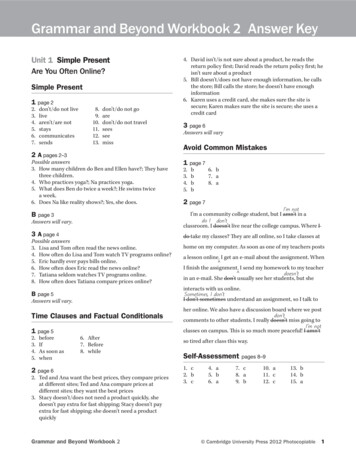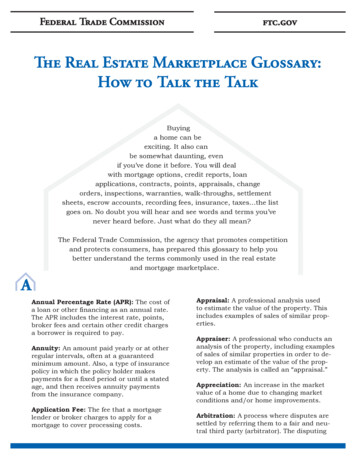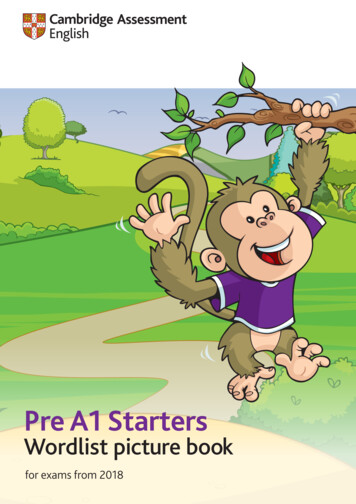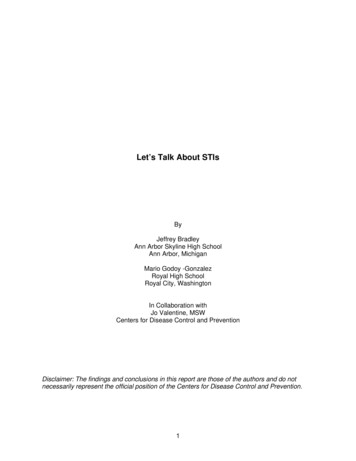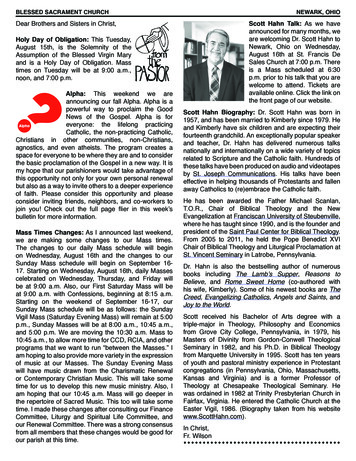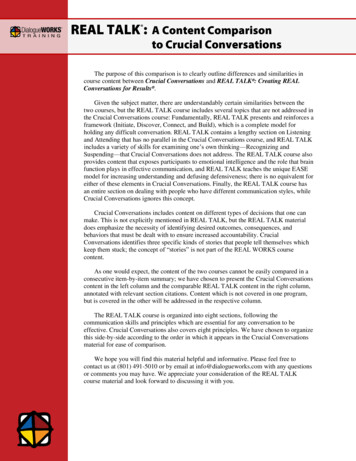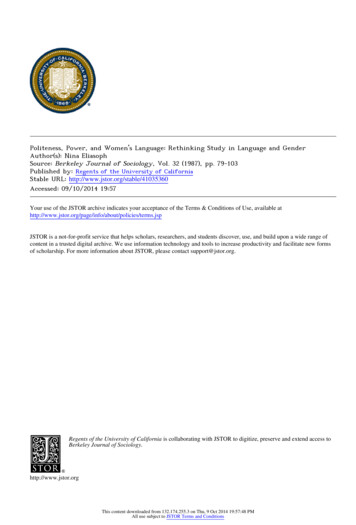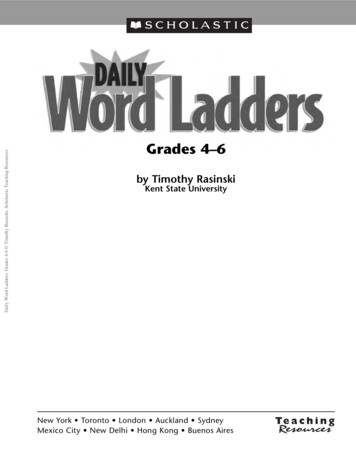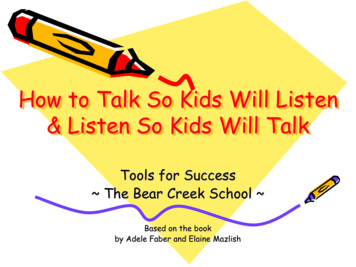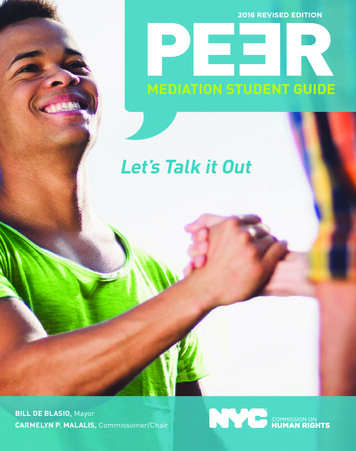
Transcription
2016 REVISED EDITIONMEDIATION STUDENT GUIDELet’s Talk it OutBILL DE BLASIO, MayorCARMELYN P. MALALIS, Commissioner/Chair
ACKNOWLEDGEMENTS Korean-American League for Civic Action, Inc. Grace Lyu-Volkhausen, Former NYC Human Rights Commissioner Dr. Maria Volpe, Professor and Director of the CUNY Dispute Resolution Consortium,John Jay College of Criminal Justice. Professor Carol Liebman and Professor Alex Carter, Columbia Law School Mediation Clinic Creative Response to Conflict, Inc. The Newark Goals 2000 Conflict Resolution-Peer MediationProject, Professional Development Guide. Nyack, NY: Creative Response to Conflict, Inc., 2000. Cohn, Richard. Students Resolving Conflict. Peer Mediation in Schools. Parsippany, NJ:Good Year Books, 1995. Deadrick, Ivan and James Kornbluh. Basic Mediation Certification Training Manual, Center forCourt Innovation, Harlem Justice Center, 2002 Johnson, Judith M. and Priscilla Prutzman, CCRC’s Friendly Classroom Mediation Manual: SchoolMediation From Planning to Practice. Nyack, NY: Creative Response to Conflict, Inc., 1998. Perlstein, Ruth and Gloria Thrall. Ready-to-Use Conflict Resolution Activities for SecondaryStudents. Englewood Cliffs, NJ: The Center for Applied Research in Education, 1996. Red Hook Community Justice Center, Red Hook Youth Court Regan, Bridget Esq., Mediation: A Basic Training Manual. 2001. Sadalla, Gail, Meg Holmberg and Jim Halligan, Conflict Resolution: An Elementary SchoolCurriculum. San Francisco, CA: The Community Board Program, Inc., 1990. Sam Blank Associates. Williams, James and Pat Hunter, Conflict Resolution Training for Workshop Facilitators.Nyack, NY: Creative Response to Conflict, Inc. nd.NYC Commission on Human Rights 2004 (rev. 2009, 2014, 2016)For information about the Peer Mediation Training Program sponsored by the NYC Commissionon Human Rights, call 311. This program is provided at no charge to program participants
MEDIATION STUDENT GUIDEBILL DE BLASIO, Mayor CARMELYN P. MALALIS, Commissioner/Chair
CONTENTS04111619INTRODUCTIONCommissioner Carmelyn P. Malalis.5NYC Commission on Human Rights Overview.6Protections Under the Law.8Mediation: A Brief History.9What Does Peer Mediation Offer?.10BEING A MEDIATORMediator Code of Honor. 11Understanding Conflict. 13Origins (which has general definitions). 13Responses and Outcomes. 14BIAS AND VALUESValues and Cultural Sensitivity. 17Personal Space and Non Verbal Communication. 18THE MEDIATION PROCESSSTEPSTEPSTEPSTEPSTEPSTEP45123456Preparing for the Mediation.20Delivering your Opening Statement.20Gathering Information. 23Identifying Issues. 29Exploring Options. 37Finalizing the Settlement.40and Writing the AgreementREFERENCE MATERIALSPeer Mediation Checklist.46Forms. 47Agreement to Mediate. 47Peer Mediation Referral.48Summary of Mediation.49Agreement Draft.50Peer Mediation Agreement.5 1Terms. 52Cultural Awareness Definitions. 54Further Reading. 56Notes. 57
On behalf of the NYC Commission on Human Rights,I am happy to welcome you to our Peer MediationProgram, also called “Peer” for short. Peer is an integralcornerstone of the programming the Commissionprovides to youth and students across the City. We areproud to train you and other students to become peermediators, as you are some of the Commission’s mostimportant ambassadors for human rights.The Commission was created to foster mutual understanding and respect among all peoplein New York City. In furtherance of this goal, the Commission enforces the NYC HumanRights Law (HRL) – the City’s broad anti-discrimination and anti-harassment law – andeducates City residents about its protections. Fairness, respect, and human dignity areessential parts of the justice the Commission fights for every day on behalf of and alongsideNew Yorkers. During your training sessions, you will learn about the HRL, discuss the value ofindividual and cultural diversity, and explore strategies for addressing conflicts and treatingothers with respect. When those qualities are not present in our relationships with others,inequality, inequity, injustice, resentment, conflict, and violence mayfollow. Mediation can help parties in a dispute better understandeach other’s position and feelings, and help them work towardsa fair outcome for each other. Commission staff use mediationtechniques to help resolve issues in employment, housing, andother aspects of life. Who better to understand these conflictsand possible resolutions in schools than you,a trained fellow student?As a mediator, you can help your classmates work throughtheir conflicts and encourage a more supportive, safe, andinclusive school. You can serve as a model through youractions and attitude; show other students how fairnessand mutual respect can lead to better solutions thanviolence or intimidation. You will also likely find thatalong the way you have developed some skillsthat will help you at home with your family andfriends, on the job, in your community – andindeed, throughout your life.Carmelyn P. Malalis, Commissioner and ChairNYC Commission on Human Rights
NYC COMMISSION ON HUMAN RIGHTSAN OVERVIEWOver the past 60 years, the New York City Commission on Human Rights has had differentnames and gone through many expansions of its authority – largely influenced by our country’scivil rights movement. However, what has never changed is the Commission’s dedication toits purpose: to make our City a place where all people “may work and live side by side inharmony and have mutual respect for each other, and where democracy is a living reality.”Through its Law Enforcement and Community Relations Bureaus, the Commission works toensure the protections of the City’s Human Rights Law. The New York City Human RightsLaw is one of the most comprehensive civil rights laws in the nation. The HRL prohibitsdiscrimination in employment, housing, and public accommodations based on race, color,religion/creed, age, national origin, alienage or citizenship status, pregnancy, gender(including sexual harassment, gender identity and expression), sexual orientation, disability,marital status, or partnership status. In addition, the HRL affords protection againstdiscrimination in employment based on caregiver status, criminal history, credit history,unemployment status,and status as a victim of domestic violence, stalking, and sex offenses.In housing, the HRL affords additional protections based on lawful occupation, familystatus, lawful source of income, and status as a victim of domestic violence, stalking andsex offenses. The City Human Rights Law also prohibits discriminatory harassment (i.e. theuse of force or threat of force against another individual based on their protected status),retaliation, and bias-related profiling by law enforcement.The Commission has not always had such wide-reaching and strong powers. When MayorFiorello H. LaGuardia initially created the “Mayor’s Committee on Unity” in early 1944,following devastating riots in Harlem in 1943, the Committee had no law enforcementpowers at all. The twenty to thirty members of the Committee depended upon persuasionto resolve conflicts. They were successful in promoting fair employment and educationpractices, reconciling the community in the wake of anti-Semitic conflicts in Coney Island,resolving pickets of white merchants by Harlem consumer groups, and diffusing two riotsin NYC high schools. They even helped break the color barrier in baseball, advancing theway for Jackie Robinson to join the Brooklyn Dodgers in 1947 and become the firstAfrican-American to play major league baseball.However, by 1955, it was clear that, without the power to enforce the law, the Committeecould not properly tackle the deep and complex problems of discrimination and bias in theCity. Mayor Robert Wagner called for the Committee’s restructure into the “Commissionon Intergroup Relations.” By act of the City Council (Local Law 55) and signature of theMayor, the City designated the Commission as an official city agency to encourage “mutualunderstanding and respect among all groups in the City” and “eliminate prejudice, intolerance,bigotry, discrimination and disorder,” guaranteeing equal rights for all as provided by the US6INTRODUCTION
THE COMMISSION WORKS TOENSURE THE PROTECTIONS OFTHE CITY’S HUMAN RIGHTS LAW.Constitution and New York City law. The Commission received various powers and duties,including the power to receive and investigate complaints, initiate its own investigations,and hold public hearings. In 1958, the Commission received the power to enforce the firstFair Housing law in the country to protect against discrimination in private housing (LocalLaw 80, the Fair Housing Practices Law).In 1962, the Commission on Intergroup Relations was renamed the “Commission on HumanRights.” Shortly thereafter, in 1965, the members of the City Council joined and amendedthe City’s Local Laws 55 and 80 to form the basis of what we now refer to as the New YorkCity Human Rights Law. Mayor Wagner signed the ‘new’ Human Rights Law in 1965. ThisLaw gave even broader powers of investigation and enforcement to the Commission andextended its jurisdiction to include employment and public accommodations – placeswhere services are provided to the public (e.g. movie theaters, doctors offices, restaurants,stores). At that time, the protected classes only included race, sex, age, and national origin.The Commission now has a much larger number of protected classes and can now enforcethe Law more aggressively by imposing fines, awarding monetary damages to victims ofdiscrimination, and enforcing orders to stop discriminatory practices.From the 1970s to the present, the Human Rights Law has continued to expand throughmany new amendments introduced and passed by the City Council and signed into Lawby the Mayor, such as protection from bias-related harassment and discrimination based ondisability, sexual orientation, gender identity and expression, family status, marital status,and employment protections for those with an arrest or conviction record. The Commission’sLaw Enforcement and Community Relations Bureaus have also improved their proceduresand organization to keep step with the Law. And, in November 2001, the people of New YorkCity voted to make the Commission a Charter agency – and it is now part of our officialCity Charter.To find out more about the Commission and its work, visit our website at:www.NYC.gov/HumanRightsINTRODUCTION7
PROTECTIONS UNDER THE LAWThe Human Rights Law protects people in three distinct areas: employment, housing,and public accommodations. Public accommodations are places that deliver services tothe public, such as restaurants, doctors’ offices, stores, and theaters.nnnnnnnAgeAlienage or citizenship statusColorDisabilityGenderGender identity or expressionMarital statusnnnnnnNational originPartnership statusPregnancyRaceReligion or CreedSexual orientationIn addition, the law provides protection against discrimination in EMPLOYMENT based on:nArrest or convictionnRole as caregivernCredit historynUnemployment statusnSurvivor of domestic violence, sexual violence, stalkingIn HOUSING, the law provides additional protections based on:nSource of incomenLawful occupationnPresence of childrennSurvivor of domestic violence, sexual violence, stalkingThe NYC Human Rights Law also prohibits:nBias-related harassmentnBias-based profiling by law enforcement, andnDiscrimination against internsIn all areas for all classes of protected people, the law protects you against retaliationif you file a complaint or you are a witness to someone else’s complaint.8INTRODUCTION
MEDIATION: A BRIEF HISTORYAlthough conflict resolution is as old as human beings and is practiced worldwide, theformal practice of peer mediation in the US began during the social and political movementsof the 1960s. Peer mediation developed as a response to the Vietnam War and the harshrealities of the Cold War when the proliferation of nuclear weapons posed an increasedthreat to the world. The ability to handle conflicts in a peaceful fashion became a matterof life and death.A community’s interest in solving their own problems also led to a growth of conflictresolution and mediation. Mediation taught individuals that when they improved theirinterpersonal relationships, they built stronger, more helpful communities and morerewarding lives.In the 1970s, President Jimmy Carter suggested forming Neighborhood Justice Centers,also known as community mediation programs.1 He imagined these Centers as placeswhere citizens could meet to resolve their disputes, and in the case of minor or quality oflife offenses, they provided an alternative to an overburdened court system that was notdesigned to build community. Since these Justice Centers were very local and focused, theyquickly exposed group tensions or individuals whose actions threatened the peace of thecommunity. When punishment was administered, the community service time or fines wentright back into the area where the violation had occurred - a type of ‘restorative justice.’The community mediation concept produced successful, effective, and lasting agreements.Additionally, community mediators found their work to be extremely fulfilling. The programsgrew so quickly that by the end of the 1980s, 1,500 volunteers were active in communitydispute resolution throughout New York State alone.2The success of these community mediation programs inspired mediators to bring theirprograms into schools and train students as neutral third parties to mediate their peers'disputes. Since many educators and students were unhappy with current methods ofdealing with school violence – ranging from metal detectors to detention and expulsion –peer mediation served as a positive addition in the schools that adopted it. Violencecould be prevented while those that participated gained self-confidence, pride, and asense of responsibility to one another.1 Guanci, John A. “Peer Mediation: A Winning Solution to Conflict Resolution,” Education Digest, 20022 Tyrrell, Jerry. Peer Mediation: A Process for Primary Schools. (London: Souvenir) 2002.INTRODUCTION9
WHAT DOES PEER MEDIATION OFFER?The following are some reasons why peer mediation is such a positive activity for studentswand their schools.HELPING STUDENTS:nDevelop relationship skills and communication skills in school and otherareas of their lives;nCultivate a positive place for leadership training;nDesign their own solutions to conflicts to give them a better chance of working;nLearn how to express their concerns and interests in a constructive andpeaceful manner.HELPING SCHOOLS:nn10Recognize that students understand the conflicts of their peers better thanadult mediators;Offer a time and space where disputes, often long-standing, can be resolvedwithout using valuable class time;nReduce hurtful behavior and violence;nCreate more time for learning.INTRODUCTION
BEING AMEDIATORMEDIATOR CODE OF HONORYour goal as a mediator is to understand the nature of conflict andguide your schoolmates toward a solution that each can agree to andlive with. Since many issues that come up in mediation are important,sensitive, and personal, you must be an interested, non-judgmental,and thoughtful listener.
Below is a code of honor that a mediator should uphold.3ConfidentialityWhat happens in the mediation room should stay in themediation room and not be discussed with others. As you know,gossiping is one of the main reasons people need mediation.A MEDIATOR IS AImpartialitynListen to both sides of the story to get the facts. Try to keepyour own opinions or biases out of the mediation.nnnNon-JudgmentalA mediator is not a judge. You do not decide who is right orwrong. Your language or actions should not appear judgmentalregarding the nature of the conflict or the individuals involved.nnnngood listenergood team membernon-judgmental personfair personhelperdependable personleaderperson you can trustCompetence ImpartialityOnly mediate when you feel you have the necessaryqualifications to fulfill the two schoolmates’ expectations.Self-DeterminationMediation should never result in an imposed resolution oragreement. It won’t stick. You may guide, but the disputantsmust choose the resolution that they feel will work for them.A MEDIATOR IS NOT AnnnnnConflicts of InterestIf you discover something that would interfere with yourmediating, you should tell the disputants and excuse yourselffrom the mediation. Examples of things that could affect yourability to mediate would be: a friendship with or dislike of oneof the disputants, or prior knowledge of the case.To the right are some characteristics of a good mediator.43 Regan, Bridget, Esq. Mediation: A Basic Training Manual.4 Johnson, Judith M. and Priscilla Prutzman. CCRC’S Friendly Classroom Mediation Manual:School Mediation From Planning to Practice. (NYACK: CRC, Inc., 1998)12BEING A MEDIATORnndisciplinarianperson who interruptsjudgeperson who gives ordersperson who gossipsabout mediationsfollowerperson who gives advice
UNDERSTANDING CONFLICTConflict is a natural part of life. So why is the first, and often only, response to conflict sonegative? Conflict is neither negative nor positive – it just is. Conflict reflects a tension betweendifferences. Those differences can be values, goals, or beliefs – and they can be real or perceived.And differences can be just that - different - not right or wrong. Your reaction to conflict candetermine its outcome.As a mediator, you need to understand conflict – what causes it and how people respond to it.And, as you develop a better awareness and understanding of the choices available to handleconflict, the more you will be able to help others resolve their conflicts.ORIGINSConflict comes from many sources, and often several factors combine to set off a conflict.However, you can usually trace conflict to some very basic causes:Limited Resources (scarcity – not enough to go around - thinking that everything someone elsehas subtracts from what you could have and there won’t be enough);Unmet Needs (powerlessness– victim – what others have done to you – insecurity about talents,capabilities, and value as a person measured by attention from others); andDifferent Values (others are not like you – difficulty getting outside yourself– lack of empathy forpositions or beliefs of others – self righteous ‘I’m right’ or ‘my way is best’ – threatened by difference).Additional reasons for conflict between students are the ideas or values of identity, security,control, recognition, and fairness.5Identity is a set of characteristics expressing your personality and individuality. It can alsodistinguish you as a member of a certain group. When people fight over who is someone’s bestfriend, they are fighting over a need for identity. Each one is seeking a label to express who theybelieve they are.Security is physical safety, freedom from fear and doubt, and a feeling of confidence. Thepeople fighting in the above scenario may not want their respective positions as “best friend”to be threatened.Control can mean power or authority. The need or desire for control is a more difficult sourceof conflict to handle than the need for security or identity. For the people described above, theycould feel that the position of “best friend” makes them feel powerful and important.Recognition or acknowledgement often underlies conflict. The students probably want to berecognized for their contributions or talents.5 Jasmine, Julia and Ruth Young, Conflict Resolution, Grades 5-8.(New York: Teacher Created Resources) 2004BEING A MEDIATOR13
Fairness Conflicts can be difficult to resolve because it’s difficult to negotiate conflictingvalues. When a student demands the return of a stolen property, he or she is oftenmotivated by a need for fairness more than a desire for the property.Since many factors often spark conflict, it can be hard to isolate the exact problem anddiscover the relevant issues and facts. Take a little time to sort things out and avoid jumpingto conclusions because you may miss the real issues. If a disputant says, “My problem is thatI need to get out of this class,” the student has really proposed a solution to the problem– not described the actual problem. The actual problem may be a fear of failure (need forcontrol) or a dislike of someone in the class (need for security).RESPONSESMore than simply “fight or flight,” people respond to conflict in various ways:nAvoidance, “Not now, maybe later.”nWithdrawal, “Not now, not ever.”nCompetition, “I’m right, you’re wrong.”nConfrontation, “What’s your problem?”nCommunication, “Talk to me. What’s happening?”nCollaboration, “We can work it out.”nProblem Solving, “What are we fighting about?”nCompromise, “Let’s make a deal.”OUTCOMES6When you think about conflict, you probably think about its negative consequences- fighting, yelling, tension and hurt feelings. But conflict is neutral, and it can havepositive consequences too:nnew information;nbetter communication;ndesirable changes;ncooperation instead of competition;nnew alternatives through creative problem solving;nopportunities for personal growth, empathy, and insight;nchances for lasting and stronger relationships.6 Regan adapting Katz & Associates.14BEING A MEDIATOR
Origins and Responses to Conflict7ORIGINS OF CONFLICTLIMITEDRESOURCESUNMETBASIC LICTRESPONSES TO al15BEINGA MEDIATOR7 unicationThreatsUnderstanding(verbal, esolution
BIAS ANDVALUESAs a mediator, your biases may prevent you from handling themediation in an impartial manner. Check yourself to be awareof your own biases. You can define BIAS in several ways.16BIAS & VALUES
B ent: a strong interest.I nclination: a particular disposition of mind or character; propensity liking.A ssumption: a fact, statement, or belief taken for granted.S lant: an individual or personal point of view, attitude, or opinion.Different perceptions, assumptions, and values are probably underneath the problemor conflict between the disputants. And, just like the disputants, you too have your ownperceptions, assumptions, and values. So, while you think about how the disputants’ biasesaffect each other and the conflict that brought them to mediation, you should also considerhow your biases about them or their conflict may affect the way you interact with them.These differences can involve many things like culture, gender, language, sexual orientation,custom, race, or religion.With an understanding of the other’s perceptions, assumptions, and values, all parties candevelop a tolerance for those differences and treat each other with respect/tolerance forthose differences and treat each other with respect.VALUESValues are qualities important to you that come from your belief system, such as honesty,fairness, winning, or being considerate of others. Groups or individuals you identify with oftenshape your values, your family, classmates, teammates, or neighbors. This identificationcan influence your behavior — how you dress, whom you sit with at lunch, or the clique youhang out with — and much more. Your values can also drive your decisions and shape yourattitudes. And, since not everyone shares the same values, they can also create boundariesor intolerance between other people. These boundaries can be overcome with clearcommunication and respect for others.MEDIATORS MUST NOT IMPOSE THEIR VALUES ON THE DISPUTANTS.CULTURAL SENSITIVITYA person’s cultural background can be a powerful presence in the mediation room. Culturaldifferences can stop the mediation and lead to misunderstanding. The disputants shouldrealize that their respective cultures influence the way each one deals with everydaysituations and views the world. The disputants’ cultural differences could have createdthe conflict to begin with.BIAS & VALUES17
As a mediator, you need to focus on whether those cultural differences are playing a partin the dispute and, if so, how to address them properly. Here are a couple of the basic onesyou may notice during the mediation.PERSONAL SPACEDifferent cultures relate differently to their personal space. Some individuals may standcloser to each other during conversations. The rules for setting up the room for mediationshould remove this issue, but you should notice if one disputant seems to be moving intoanother’s personal space. The other disputant could get uncomfortable and misunderstandthis as a sign of aggression or hostility.NON-VERBAL COMMUNICATIONOther than the words you use to get your thoughts and feelings across to another person,you also use non-verbal behaviors like facial expressions, posture, characteristic movements,gestures, and eye contact. How you dress also can be a form of non-verbal communicationby making a ‘statement’ about you.People who are more reserved may hide their emotions with a “poker face” and feeluncomfortable with physical contact and expressiveness. A mediator should pay attentionto these individual or cultural differences, and the mediator’s own, and address them withthe disputants if they interfere with the mediation.Other non-verbal cues include loudness, pauses, silences, and rates of speech — eveninterruptions. In some cultures, interruptions are not always rude. They can be a sign thatthe person is interested, involved and paying attention — a type of “active listening.”Some cultures let emotions flow freely and display bursts of emotion. Persons from a morereserved culture may misinterpret loudness as aggressive, hostile, or ‘too much.’ They mayshut down.AS A MEDIATOR YOU SHOULDN’T EXCUSE OR BLAME INTERRUPTIONS,ALOOFNESS, OR PERCEIVED RUDENESS ON CULTURE OR INDIVIDUALDIFFERENCES. BOTH PARTIES HAVE A RESPONSIBILITY TO THE MEDIATION.18BIAS & VALUES
THEMEDIATIONPROCESSNow you can review the mediation process and put it to practice. Asyour skill as a mediator develops and your confidence grows, you willprobably make changes to fit your style, comfort level and personality.
Check over each step of the mediation process and the skills or techniques necessary tomove the mediation along to a successful outcome. Remember, mediation may not alwaysfollow exactly in this way. These steps are only a helpful guide.81 Preparing For The Mediation2 Delivering Your Opening Statement3 Gathering Information4 Identifying Issues, Interests, and Feelings5 Exploring OptionsSTEP 1PREPARING FOR THE MEDIATIONAfter reviewing the mediation steps and helpful ideas to identify and resolve theconflict, you should begin by looking over the room arrangement. A well-arrangedroom encourages successful mediation and reinforces the goals of equality andopen communication. Some things for you to consider when preparing theroom are:1 CHAIRS The same kind for each disputant should be placed so thatdisputants are diagonally facing each other with or without a table.2 PLACEMENT One mediator should sit near and with their back to thedoor if an adult coordinator is not present so that someone can be notifiedif a problem arises.3 SPACE Each disputant should have the same amount of space.4 NO EATING OR CELL PHONES during the mediation.STEP 2DELIVERING YOUR OPENING STATEMENTYour opening statement sets the mood for the mediation, establishes your roleas a neutral party in the mediation and develops a constructive relationshipbetween you and the disputants. It also sets out ground rules.8 Regan20THE MEDIATION PROCESS
YOUR CHECKLIST Introduce yourself. Establish impartiality. Establish your credentials as a Mediator(i.e. training and experience) to promote trust and confidence. Explain your role and the purpose of the mediation session.nnn Mediation is a preferred alternative to disciplinary actions(like suspension), violence or continued conflict and hostility.Mediators cannot impose a settlement, but will help themidentify the source of the pro
Deadrick, Ivan and James Kornbluh. Basic Mediation Certification Training Manual, Center for Court Innovation, Harlem Justice Center, 2002 . it was clear that, without the power to enforce the law, the Committee could not properly tackle the deep and complex problems of discrimination and bias in the
